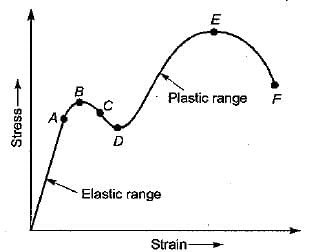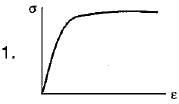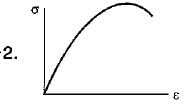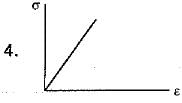Test: Mechanical Properties of Materials - 3 - Mechanical Engineering MCQ
30 Questions MCQ Test - Test: Mechanical Properties of Materials - 3
A material capable of absorbing large amount of energy before fracture is known as
The following figure shows the stress-strain curve for tensile test on a mild steel specimen.

Q. The upper yield point is represented by the point

Select the proper sequence
1. Proportional limit
2. Elastic limit
3. Yielding
4. Failure
The stress-strain curve for glass during tensile test would exhibit
The impact strength of a material is an index of its
What are the materials which show direction dependent properties?
A material has identical properties in all directions, it is said to be
The material in which large deformation is possible before the absolute failure or rupture is termed as
What is the phenomenon of progressive extension of the material i.e. strain increasing with the time at a constant load, called?
The stress level, below which a material has a high probability of not failing under reversal of stress, is known as
The energy absorbed in a body, when it is strained within the elastic limits, is known as
Toughness for mild steel under uniaxial tensile loading is given by the shaded portion of the stress-strain diagram as shown in
Which one of the following pairs is NOT correctly matched?
The linear relation between the stress and strain of a material is valid until
Limit of proportionality depends upon
The stress-strain curve for an ideally plastic materia! is
Match List-I (Materials) with List-II (Stress-Strain curves) and select the correct answer using the codes given below the lists:
List-I
A. Mild steel
B. Pure copper
C. Cast iron
D. Pure aluminium
List-II




Codes:
A B C D
(a) 3 1 4 1
(b) 3 2 4 2
(c) 2 4 3 1
(d) 3 2 4 1
Match list - I with list - II and select the correct answer using the codes below:
List - I
A. Ductility
B. Brittleness
C. Tenacity
D. Toughness
List - II
1. Failure without warning
2. Drawn permanently over great changes of shape without rupture.
3. Absorption of energy at high stress without rupture.
4. High tensile strength
Which one of the following properties cannot be evaluated by static tension test?
The percentage elongation of a material as obtained from static tension test depends upon the
Modular ratio of two materials is the ratio of
Proof resilience per unit volume of a material is known as .
An axial residual compressive stress due to a manufacturing process is present on the outer surface of a rotating shaft subjected to bending. Under a given bending load, the fatigue life of the shaft in the presence of the residual compressive stress is
















